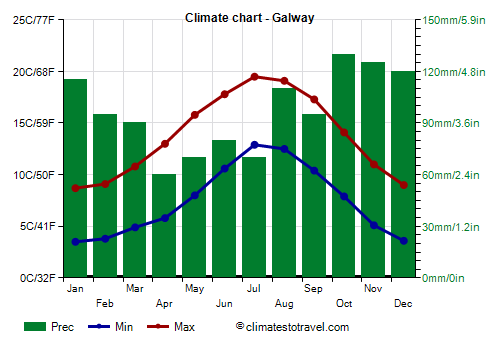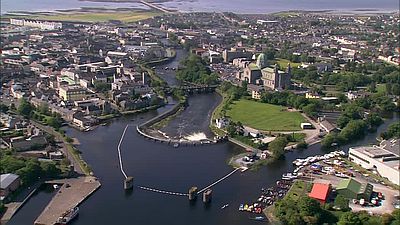Select units of measurement for the temperature and rainfall tables (metric or imperial).
Average weather, temperature, rainfall, sunshine hours

The climate of Galway is
oceanic, with quite mild, rainy winters and mild, relatively rainy summers.
The city is located on the west coast of Ireland, in Galway Bay, and belongs to the province of Connacht.
North of the city, the River Corrib widens to form the largest lake in the Republic of Ireland, Lough Corrib.
The
average temperature of the coldest month (January) is of 6.1 °C (43 °F), that of the warmest month (July) is of 16.2 °C (61 °F). Here are the average temperatures.
Galway - Average temperatures (1981-2010) |
| Month | Min | Max | Mean |
|---|
| January | 3.5 | 8.7 | 6.1 |
|---|
| February | 3.8 | 9.1 | 6.4 |
|---|
| March | 4.9 | 10.8 | 7.8 |
|---|
| April | 5.8 | 13 | 9.4 |
|---|
| May | 8 | 15.8 | 11.9 |
|---|
| June | 10.6 | 17.8 | 14.2 |
|---|
| July | 12.9 | 19.5 | 16.2 |
|---|
| August | 12.5 | 19.1 | 15.8 |
|---|
| September | 10.4 | 17.3 | 13.8 |
|---|
| October | 7.9 | 14.1 | 11 |
|---|
| November | 5.1 | 11 | 8 |
|---|
| December | 3.6 | 9 | 6.3 |
|---|
| Year | 7.4 | 13.8 | 10.6 |
|---|
amounts to 1,155 millimeters (45.5 inches) per year: it is therefore quite abundant. It ranges from 60 mm (2.4 in) in the driest month (April) to 130 mm (5.1 in) in the wettest (October). Here is the average precipitation.
Galway - Average precipitation| Month | Days |
|---|
| January | 115 | 15 |
|---|
| February | 95 | 14 |
|---|
| March | 90 | 16 |
|---|
| April | 60 | 12 |
|---|
| May | 70 | 12 |
|---|
| June | 80 | 12 |
|---|
| July | 70 | 12 |
|---|
| August | 110 | 15 |
|---|
| September | 95 | 13 |
|---|
| October | 130 | 17 |
|---|
| November | 125 | 17 |
|---|
| December | 120 | 17 |
|---|
| Year | 1155 | 170 |
|---|
, from December to February, is quite mild, but wind and humidity can increase the sensation of cold. The sky is often cloudy, and rainfall is frequent. Sometimes, intense Atlantic depressions can cause wind storms.
Snowfalls are rare and not abundant. Usually, cold spells are not intense and do not last long. The temperature rarely drops below -5 °C (23 °F), however, it can occasionally drop to lower values. The coldest record is -11.7 °C (10.9 °F) and was set in January 1945.
In
spring, from March to May, the temperature slowly rises, and Atlantic fronts become a bit less frequent. In May, it is often still quite cold, especially in the first half of the month.
Summer, from June to August, is cool, with quite frequent rains, in a context of variable weather.
Hot days are rare: the temperature may not reach 25 °C (77 °F) for an entire month. However, it can sometimes reach higher values. In the last decades, it reached 30.5 °C (87 °F) in June 1976.
Autumn, from September to November, is gray, cloudy and rainy, and with each passing week, it gets progressively colder. In November, the wind is often moderate or strong.

The
sea temperature ranges between 10 °C (50 °F) and 16 °C (61 °F). So, it never becomes warm for swimming. Here are the average sea temperatures.
Galway - Sea temperature| Month |
|---|
| January | 10 |
|---|
| February | 10 |
|---|
| March | 9.5 |
|---|
| April | 10 |
|---|
| May | 11.5 |
|---|
| June | 13.5 |
|---|
| July | 15.5 |
|---|
| August | 16 |
|---|
| September | 15 |
|---|
| October | 13.5 |
|---|
| November | 12"> |
|---|
| December | 11 |
|---|
| Year | 12.3 |
|---|
Best Time
The best time to visit Galway is the summer,
from June to August, since it is the mildest of the year. The temperatures are generally good for outdoors activities, although it's better to bring an umbrella, and a sweatshirt or sweater for the evening or for cool days.